The debate between on-page and off-page SEO continues to shape how websites compete for online visibility. Whether you’re a seasoned pro or just getting started, understanding these two sides of SEO is key to noticing your site. But what exactly makes them different, and how do they each influence your website’s performance in search results?
In this guide, we’ll explain the on-page and off-page SEO and show how they work together to boost your online presence. From fine-tuning your website’s content to building strong backlinks and brand mentions, we’ll explore the crucial strategies to elevate your SEO game. Let’s dive in and see the differences between each component.
On-Page SEO: components & impact on SERP visibility

On-page SEO is a search engine optimization strategy. It includes all the elements you can directly control within your website to improve its ranking and visibility on search engine results pages (SERPs). Let’s explore the key components of on-page SEO and how they impact your website’s performance in the eyes of search engines.
#1 Content quality
Content quality is a key factor in the world of SEO. As a website owner or content writer, you want your visitors to gain valuable information, right? That’s why we always emphasize the importance of creating content that is rich in information and engaging and relevant to your readers.
Imagine you’re writing an article about “how to care for indoor houseplants.” You wouldn’t want to provide a list of steps. Instead, you’d like to share your personal experiences and tell a story about how you saved a plant that was almost dying. This is what we mean by quality content—informative but also entertaining and inspiring.
Some key elements of high-quality content include:
- Depth and breadth of topic coverage
- Clear and easy-to-understand language
- A logical and easy-to-follow structure
- Use of relevant multimedia (images, videos, infographics)
- Regular content updates
Impact content quality on SERP:
High-quality content significantly increases your website’s chances of ranking at the top of SERPs. Search engines like Google actively seek out content that provides the best value to users and will prioritize such content in their search results.
#2 Keywords
Keywords are the main link between your content and what users are searching for. Imagine you’re conversing with a search engine, and your job is to use the right words so they understand your topic!
For example, if you’re writing an article about “how to make the perfect coffee,” you might want to use keywords like “coffee brewing techniques,” “coffee-to-water ratio,” or “choosing coffee beans.” However, it’s important to remember that keywords should appear naturally in your content, not just be inserted randomly.
Here are some tips for effective keyword usage:
- Use your primary keyword in the title, subheadings, and opening paragraph.
- Include keyword variations throughout your content.
- Ensure keyword usage feels natural and not forced.
- Utilize long-tail keywords to target more specific audiences.
Let’s say you own an online coffee shop. Instead of targeting just “coffee,” which is highly competitive, you could focus on “finely ground Arabica coffee for French press.” This will help you reach a more specific audience that is ready to purchase.
The following is an example of the distribution of the keyword “shopify store localization” in an article. In the following image, the keyword is found in the opening article and subtitle.

Impact keywords on SERP:
Using the right keywords helps search engines understand the relevance of your content to user queries. This increases the chances of your content appearing in relevant search results, potentially increasing traffic to your website.
#3 Slug
A slug is the part of a URL that identifies a specific page on your website. It’s like the address for each of your pages. Just as you’d want your home address to be easy to remember and pronounce, you want your slug to be user-friendly and search engine-friendly.
For an article titled “10 Healthy Smoothie Recipes for Breakfast,” a good slug might be www.yourblog.com/healthy-smoothie-recipes
Compared to a less optimal slug: www.yourblog.com/post-123456-10-healthy-smoothie-recipes-for-breakfast-delicious-and-nutritious
Here are some tips for optimizing slugs:
- Keep them short and clear
- Include the main keyword
- Use hyphens (-) to separate words
- Avoid using numbers or special characters
Here is the slug or URL with the keyword “how to increase website traffic”.
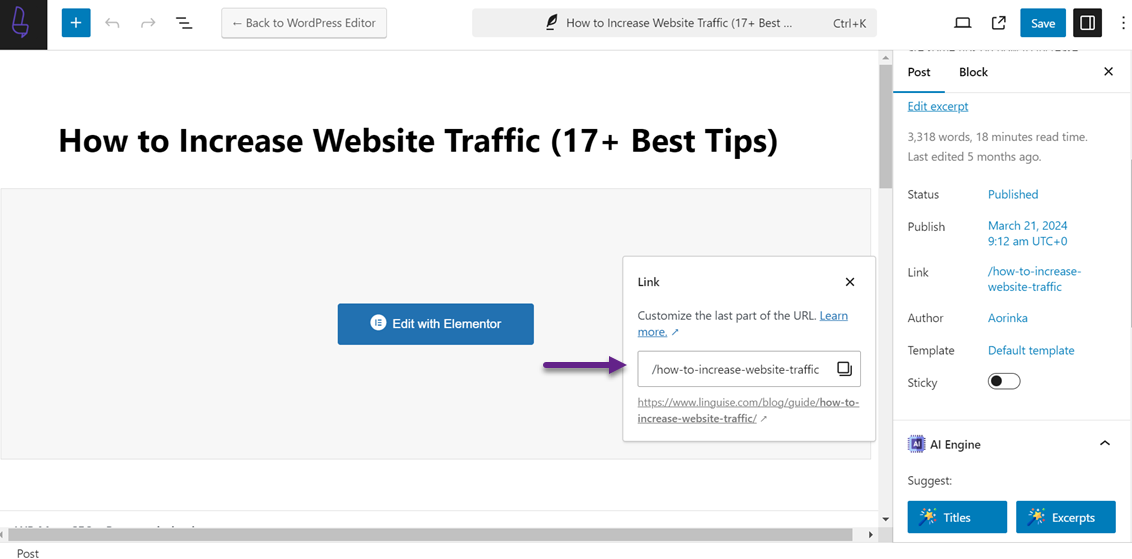
Impact slug on SERP:
A well-optimized slug can enhance search engines’ understanding of your page content, improving your ranking in SERPs. Additionally, user-friendly slugs can boost click-through rates from search results.
#4 Heading structure
The heading structure in your content acts as a roadmap for readers and search engines. It helps them understand the hierarchy and organization of your information. Imagine writing a cookbook. You wouldn’t want all the recipes piled into one large section, right? Instead, you’d organize them neatly—perhaps by type of food or meal time.
The same principle applies to your web content. Proper use of headings (H1 through H4) helps break your content into digestible sections.
Example of a good heading structure:

Tips for effective heading structure:
- Use H1 for the main title of the article.
- Utilize H2 for major subtopics.
- Employ H3 and H4 for further details.
- Ensure headings contain relevant keywords.
- Maintain consistent structure throughout your website.
Impact heading structure on SERP:
A well-structured heading system helps search engines better understand your content, which can improve your ranking in SERPs. It also enhances user experience, reducing bounce rates and increasing the time spent on your page—factors that search engines consider.
#5 Meta description
A meta description is a brief summary of your web page’s content. Think of it like a movie trailer—you only have a few seconds to grab the viewer’s attention and make them want to learn more. In this case, your “viewers” are users seeing your search results.
For example, if you run an online store selling handmade shoes, your product page meta description might read: “Discover our exclusive collection of handmade shoes. Unique options for your style. Free shipping on orders over Rp 500,000!”
The following is an example of a meta description in a Linguise article.

Here are some tips for crafting a compelling meta description.
- Keep it to around 155-160 characters
- Include primary keywords
- Provide an accurate summary of the page content
- Add a call-to-action if relevant
- Make each one unique for different pages
Impact meta description on SERP:
Although meta descriptions are not a direct ranking factor, they play a crucial role in the click-through rate (CTR) of search results. An engaging and informative meta description can encourage more users to click on your link, boosting traffic and indirectly influencing your ranking.
#6 Internal & external links
This on-page SEO component connects various parts of your website (internal linking) and directs visitors to valuable external resources.
For example, if you’re writing an article on “How to Start an Online Business,” you might link internally to your article on “E-commerce Beginner’s Guide” and externally to the official site for business registration in your country.
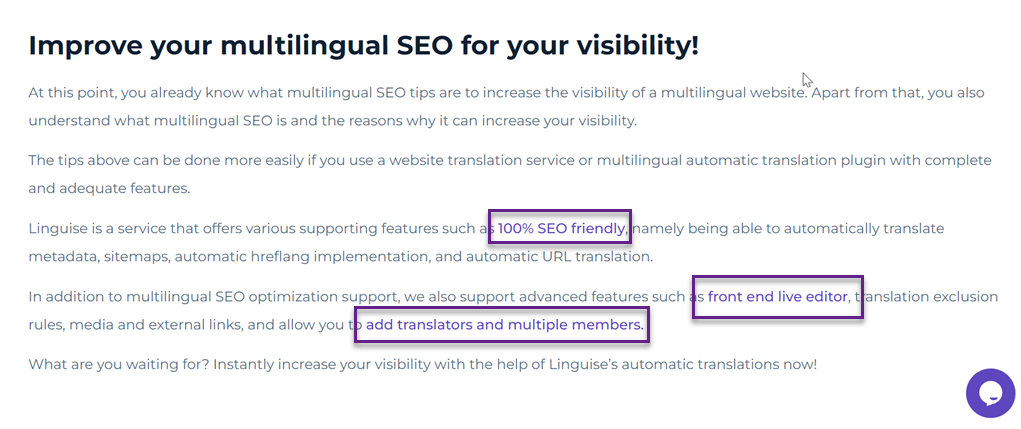
Here are some best practices for linking:
Internal Linking:
- Use descriptive anchor text
- Link to relevant content
- Distribute links evenly throughout the content
External Linking:
- Choose reputable and authoritative sources
- Ensure links open in a new tab (use the “noopener” attribute for security)
- Consider using the “nofollow” attribute for paid or less trustworthy links
Remember, quality is more important than quantity. The goal is to assist your readers, not overwhelm them with a sea of links!
Impact internal & external links on SERP:
Internal links help search engines understand your website’s structure and hierarchy. External links to reputable sources can enhance your content’s credibility in the eyes of search engines. Both contribute to improving your SERP ranking.
#7 Title tags
The title tag is an HTML element that defines the title of your web page. It’s like the title of a book—the first thing people see when they find your page in search results. You want to make it engaging, informative, and to the point.
For instance, a good title tag for an article on plant care might be “10 Tips for Indoor Plant Care | Complete Guide 2024.”
Here are some tips for creating an effective title tag.
- Limit length to 50-60 characters
- Include the main keyword at the beginning if possible
- Make each title unique to its page
- Ensure it accurately reflects the page content
Impact title tags on SERP:
The title tag is one of the most important on-page SEO factors. It is the first element seen by search engines and users, playing a crucial role in determining the relevance of your page to search queries. A well-optimized title tag can improve your click-through rate (CTR) from search results, boosting your SERP ranking.
#8 Image optimization
Images are not just visual enhancements for your content—they can also be powerful SEO assets when optimized correctly. For instance, if you run a food blog, mouth-watering photos of dishes can make your readers hungry and help search engines understand your content better.
The following is one of the ALT Texts from the Linguise article illustration.
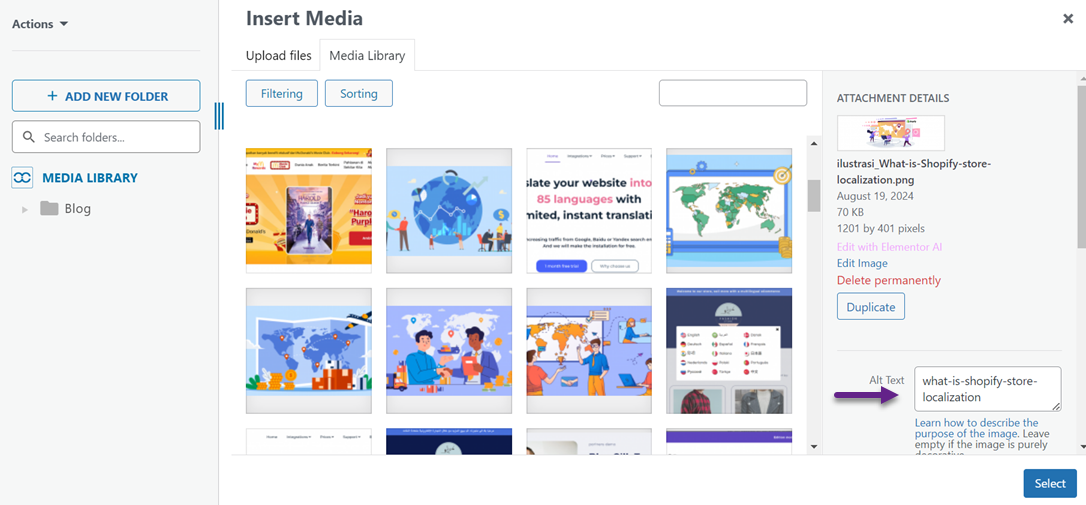
Here’s how to optimize images effectively.
- Descriptive File Names: Use “creamy-carbonara-pasta-recipe.jpg” instead of “IMG_12345.jpg”.
- Informative Alt Text: For example, “Plate of creamy carbonara pasta with parmesan topping”.
- Image Compression: Tools like TinyPNG can reduce file size without sacrificing quality.
- Correct File Formats: Use JPEG for photos, PNG for transparent images, and WebP for better web performance.
- Responsive Images: Ensure images look good on all screen sizes.
Remember, optimizing images improves SEO and enhances the visual experience for your website visitors.
Impact image optimization on SERP:
Well-optimized images can boost page loading speed, which is a ranking factor. They can also appear in Google Image search, providing an additional pathway for users to discover your content. Furthermore, effective alt text helps search engines understand the context of your images, potentially enhancing your page’s relevance for specific queries.
#9 Page load speed
Speed is crucial! Imagine you’re hungry and want to order food online. If your favorite restaurant’s website takes over a few seconds to load, you will likely switch to a competitor.
The same principle applies to your website visitors. Page loading speed isn’t just about user convenience—it’s also a significant SEO ranking factor.
Here are some ways to improve page loading speed:
- Optimize images (as previously discussed)
- Minify CSS, JavaScript, and HTML
- Use browser caching
- Reduce unnecessary plugins
- Implement a Content Delivery Network (CDN)
- Optimize your CSS and JavaScript code
- Consider faster hosting
Remember, every second counts! According to a Google study, the probability of a bounce increases by 32% when page load time rises from 1 second to 3 seconds. Investing time and resources into speed optimization is well worth it.
Use tools like Google PageSpeed Insights or GTmetrix to analyze your website’s speed and get improvement recommendations. The results will speak for themselves!
Impact page load speed on SERP:
Page loading speed is a ranking factor officially recognized by Google. Faster websites tend to achieve higher rankings in SERPs. Additionally, improved speed enhances user experience, reducing bounce rates and increasing time spent on the site—both positive signals to search engines.
#10 Multilingual SEO
In an increasingly connected world, reaching a global audience is more important than ever. Imagine running an online store selling unique Indonesian products. With multilingual SEO, you can expand your reach beyond Indonesia to potential buyers around the globe!
Multilingual SEO involves optimizing your website for multiple languages. It’s not just about translating your content—it’s about tailoring the entire user experience for an international audience.
Below is a multilingual website with default English that has been translated into Spanish and many other language options.
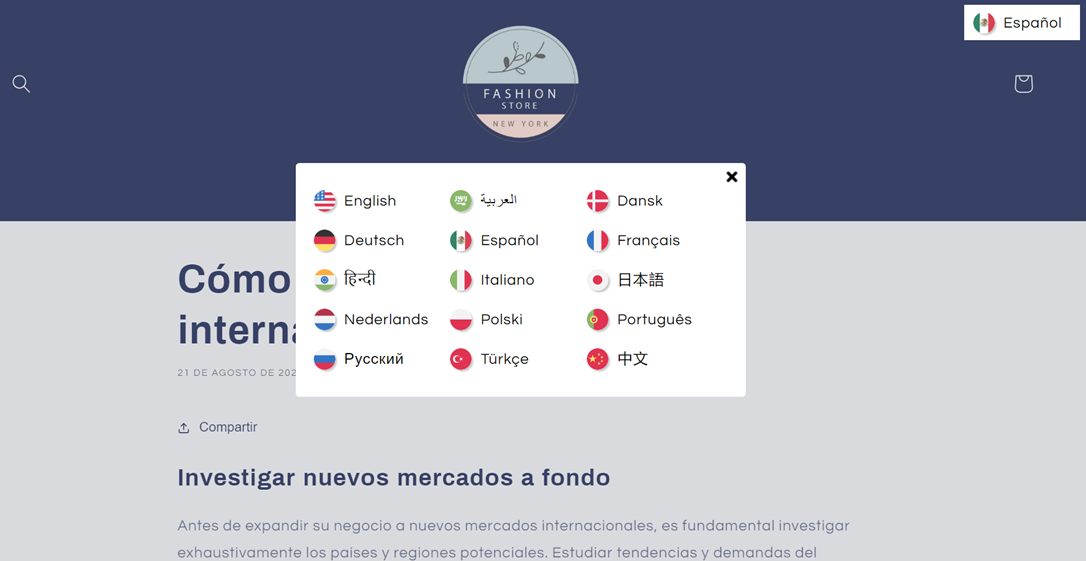
Key steps for implementing multilingual SEO include.
- Use proper URL structures: For example, use example.com/id/ for Indonesian and example.com/it/ for Italian.
- Implement hreflang tags: These tell search engines about different language versions of your page.
- Translate all on-page elements: This includes meta titles, meta descriptions, alt text, and more.
- Adjust keyword research: Conduct local and international keyword research for each target language.
- Localize your website: Adapt content and design to fit cultural differences and local preferences.
Implementing multilingual SEO requires time and effort but can be highly rewarding. It allows you to tap into new markets and increase global traffic.
To simplify this process, consider using tools like Linguise, an automatic translation website that makes it easy to translate your site and implement best practices for multilingual SEO without deep technical expertise.
Impact multilingual SEO on SERP:
Multilingual SEO can significantly boost your website’s global visibility. Offering content in multiple languages enhances your chances of appearing in search results across various countries and regions. This can increase international organic traffic and potentially expand your customer base.
Off-Page SEO: components & impact on SERP visibility

Off-page SEO refers to optimization activities performed outside of your own website to enhance its ranking and visibility in search engines. Unlike on-page SEO, which focuses on content and internal structure, off-page SEO emphasizes building your website’s authority and credibility in the eyes of search engines through external factors.
#1 Backlinks
Ever wondered why some websites always appear on the first page of Google? The answer might lie in backlinks. Backlinks are links from other websites pointing to yours. Think of backlinks as recommendations from friends—the more people recommend you, the more trusted you become.
Building high-quality backlinks isn’t easy, but it’s worth the effort. By acquiring backlinks from reputable sites within your industry, you signal to Google that your content is valuable. It’s like receiving endorsements from experts in your field.
Impact backlinks on SERP:
High-quality backlinks can enhance your website’s authority and trustworthiness in the eyes of search engines. As a result, your rankings in search engine results pages (SERPs) will likely improve, bringing more organic traffic to your site.
#2 Domain authority
Have you heard of “Domain Authority” or DA? It’s a score that reflects how strong and influential a website is in the eyes of search engines. Think of DA as a report card for your website—the higher the score, the better your performance in the online world.
Improving DA isn’t an overnight process, but don’t worry! You can gradually build your domain authority with consistency and the right strategies. Focus on creating high-quality content, acquiring relevant backlinks, and providing a great user experience. Remember, in the world of SEO, patience and perseverance are key.
Impact domain authority on SERP:
A high Domain Authority generally leads to better rankings in SERPs. This means your website has a greater chance of appearing at the top of search results, boosting visibility and potential traffic.
#3 Social media
Did you know that our social media activities can impact off-page SEO? While likes and shares on social media don’t directly affect SEO rankings, they are crucial in building brand awareness and driving traffic to our website.
Think of social media as a bridge between you and your audience. When you share engaging content or interact with followers, you open up opportunities to reach more people. This can lead to increased visits to your website, more backlinks, and ultimately, positive signals to search engines that your content is valuable.
Impact social media on SERP:
Although it doesn’t directly impact rankings, strong social media activity can boost brand visibility, drive traffic, and indirectly influence factors contributing to better SERP rankings.
#4 Online reviews
Have you ever read online reviews before making a purchase? We all do, right? Online reviews are a powerful form of social proof. They not only influence potential customers’ decisions but also send signals to search engines about the quality and reputation of your business.
Getting positive reviews might seem challenging, but it’s an opportunity to showcase the quality of your service. Whenever you provide an outstanding customer experience, you open the door to positive reviews. And remember, even negative reviews can be a chance to demonstrate how professionally you handle issues.
Impact online reviews on SERP:
Positive reviews can boost trust from both users and search engines. They can also enhance local visibility in SERPs, especially for searches related to local businesses or services.
#5 Guest posting
Have you ever considered guest posting on other blogs or websites? Guest posting is a highly effective off-page SEO strategy. It’s like being invited to speak at an industry event—you can share your knowledge with a new audience and establish your authority in the field.
When you write informative and valuable guest posts, you gain high-quality backlinks and build relationships with influencers and other websites in your industry. This can lead to further collaborations and expand your reach. Remember, quality always outweighs quantity in guest posting.
Impact guest posting on SERP:
Well-executed guest posting can provide high-quality backlinks, enhance domain authority, and expand the reach of our content. These factors contribute to increased visibility in SERPs and the potential for higher rankings for our target keywords.
Difference between on-page SEO vs off-page SEO
After we have discussed each on-page and off-page component, below we summarize several points of difference between the two by looking at several aspects.
Aspects | On-page SEO | Off-page SEO |
Focus | Optimization of elements within one’s website | Optimization of factors outside the website |
Control | Entirely under the website owner’s control | Mainly outside the direct control of the website owner |
Main components | Content, meta description, URL structure, website speed, image optimization, heading structure, linking, keywords, slug, title tags | Backlinks, domain authority, social media activities, online reviews, guest posting |
Purpose | Improve relevance and quality of content for users and search engines | Build website authority and credibility in the eyes of search engines |
Implementation | Relatively faster and more direct | Requires more time and involves external parties |
Conclusion
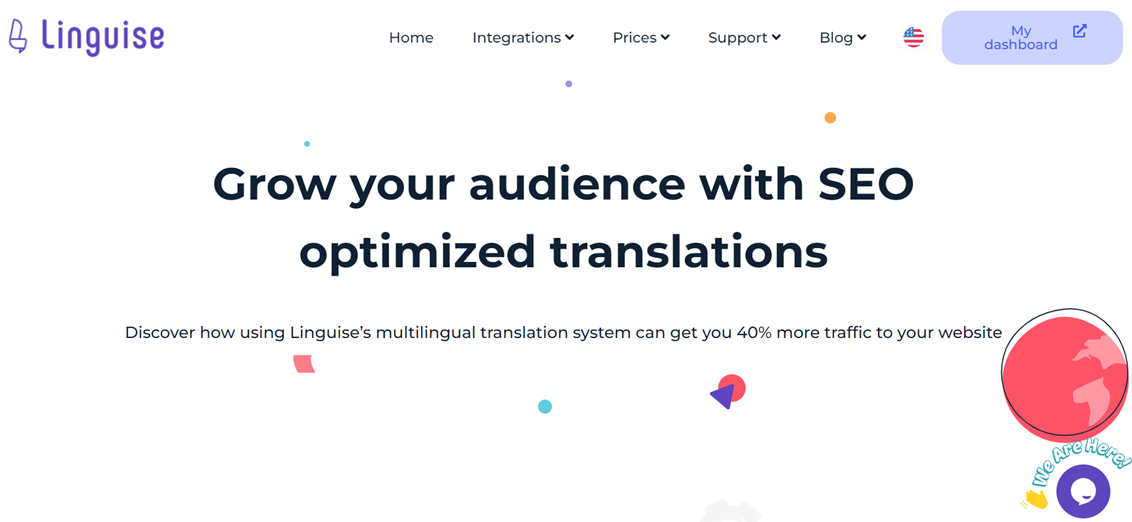
Understanding and implementing on-page and off-page SEO strategies are crucial for enhancing your website’s visibility in search engines. On-page SEO allows you to optimize elements within your direct control. At the same time, off-page SEO helps build your website’s authority and trustworthiness in the eyes of search engines and users. Together, these aspects create a comprehensive and effective SEO strategy.
Remember, SEO is an ongoing process that requires consistency and adaptation to search engine algorithm changes. If you want to expand your global reach, don’t forget to leverage translation services like Linguise to optimize your multilingual SEO and translation efforts.



